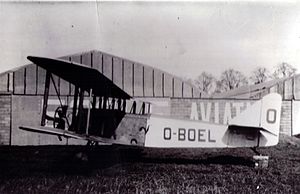|
Stampe et Vertongen RSV.32
The Stampe et Vertongen RSV.32[4] was a trainer aircraft produced in Belgium in the early 1920s.[1] Designed originally for the Stampe et Vertongen flying school,[5] the Belgian Air Force became a major operator of the type,[6] where it became the first aircraft of entirely Belgian design and manufacture to enter service.[2][3] Many others were purchased by flying clubs and private owners.[7] No RSV.32 was in existence by the end of World War II.[8] HistoryJean Stampe and Maurice Vertongen, veterans of World War I, founded a flying school at Deurne in 1923.[9] Their research into the training aircraft then available led them to believe that the British-built Central Centaur IV was the best choice for their school.[5] When they discovered that the Centaur IV had just ceased production, their friend, Maurice Boel, introduced them to engineer Alfred Renard, whom Stampe and Vertongen contracted to design a similar aircraft that could be built cheaply and locally.[5] Renard's response was a conventional two-bay biplane with unstaggered wings of equal span.[10] Power was provided by a radial engine in the nose.[10] The student pilot and instructor sat in tandem in a single, open cockpit[10] and communicated through a speaking tube.[11] The main units of the fixed undercarriage shared a common axle, and the tail was supported by a skid.[10] Construction was of wood throughout, braced with wire and covered in fabric,[8] and stressed to withstand rough treatment by student pilots.[12][13] To reduce costs, many parts were interchangeable, including the struts, longerons, undercarriage legs,[13] and even the upper and lower wings.[12] Initial construction of the prototype commenced in a dance hall in Evere[2][8] and was completed in the hangar of the Administration de l'Aéronautique[2] (the Belgian Aviation Administration) on 23 April 1923,.[13] The aircraft was registered O-BOEL in honour of the friend who introduced Renard to Stampe and Vertongen.[2][13] After the prototype had been tested, King Albert I paid a royal visit to Stampe et Vertongen and asked for a joy ride over Antwerp in it.[8] The RSV.32 was produced between 1923 and 1932[2][11] and the total number built is sometimes given as fifty-seven,[14] however Paul de Meyer, writing for Air-Britain Digest in 1980 called this number "unlikely" and "greatly exaggerated".[3] The type saw service with not only Stampe et Vertongen's school, but flying schools at Gosselies and Saint-Hubert as well.[2] The Belgian Air Force purchased nineteen examples in three batches.[6] These served until 1936, when surviving machines were sold to private owners.[8] Flying clubs that operated the type included the Antwerp Aviation Club[7] and the Aéro-Club Royal Belge.[7] At least one private owner added a third seat to the aircraft,[15] and at least three examples were converted to 2+2 seating[8] with a fuselage modification designed by Renard.[2] This latter configuration was designated the RSV.32/2X2.[2] VariantsThe RSV.32 was built in at least seven variants. The precise subtype is known for forty-one aircraft:[16]
Additionally, one RSV.32 was to be fitted with an 82-kW (110-hp) Renard engine and possibly amphibious undercarriage, but this machine was never built.[21] Finally, note that some of these aircraft were converted from other subtypes, so the same airframe might in some cases be counted twice in the production figures.[3] OperatorsSpecifications (RSV.32/90)Data from Jouhaut 1999, p.33, except as noted General characteristics
Performance
See alsoRelated lists Notes
ReferencesWikimedia Commons has media related to Stampe et Vertongen RSV.32.
|
||||||||||||||||||||
Portal di Ensiklopedia Dunia
